CruiseNews #33
Date: 31 October, 2000
Port of Call: Puerto La Cruz, Venezuela
Subject: The Best Kept Secret
"Venezuela: El secreto mejor guardado del Caribe" (The best kept
secret of the Caribbean) say the posters on the walls of travel agents
here. It's possible they are right. Few of the boaters who
make the run through the chain of the West Indies venture off the beaten
track to Venezuela. Of the few who come here, fewer still leave the
relative isolation and perceived safety of Venezuela's offshore islands
to explore the mainland. For the last few weeks, we have been delving
the secrets hidden away in the Andes Mountains of Venezuela.
We had heard a little about the Venezuelan Andes from a few other cruisers
in the Caribbean during the last year. They described beautiful scenery
and (most important to me) cool temperatures. Some boaters actually
showed us photographs of SNOW! After enduring a year of 24-hour-a-day
perspiration, we were hooked; we had to get cool. On October 5th,
we pulled into Bahia Redonda Marina in Puerto La Cruz, where Sovereign
would stay for the duration of our trip. Four days later Cathy and
I, along with Michael and Kay from "Toluso" boarded the "Ejecutivo", or
first-class bus, bound for Merida.
The bus ride was long, about 20 hours, but at a third the price of airfare,
it was really our only option. We had hoped to use the bus ride to
orient ourselves to the Venezuelan mainland by watching the scenery roll
by and following our progress on a map. When we stepped aboard, we
found the bus shrouded with blackout curtains and staffed by a "conductor"
who scolded us if we opened the curtains. We settled in for the long
ride, which at least was made fairly comfortable by air conditioning, movies,
a bathroom, and plush seats that reclined far back and also had leg supports
like an easy chair. The bus stopped several times for us to stretch
our legs and eat. The food sold at the bus stops was "arepas", corn-flour
cakes about the size of english muffins (crumpets for our English readers),
stuffed with either cheese, meat, or chicken, and ranging in quality from
good to inedible. The other noteworthy feature of the bus stops was
that they used an interesting but effective deodorizer in the men's urinals:
sliced fresh limes…hundreds of them.
Plaza Bolivar, Merida
 We arrived in Merida
the next morning around 6:00 A.M., and when we stepped off the bus into
the bright, crisp morning air that only a mile-high city can provide, we
knew we were in the right place. At about 9 degrees of latitude north
of the equator, the temperatures are consistent all year round, and at
an altitude of a mile above sea level, they are also very agreeable.
Highs are typically in the mid-seventies Fahrenheit, and lows are around
60--like a New England summer--all year long!
We arrived in Merida
the next morning around 6:00 A.M., and when we stepped off the bus into
the bright, crisp morning air that only a mile-high city can provide, we
knew we were in the right place. At about 9 degrees of latitude north
of the equator, the temperatures are consistent all year round, and at
an altitude of a mile above sea level, they are also very agreeable.
Highs are typically in the mid-seventies Fahrenheit, and lows are around
60--like a New England summer--all year long!
The first of many posadas
 After breakfast
at the bus station coffee shop, we caught a local bus to downtown Merida
and began the Great Posada Hunt. Posadas are like "Bed and Breakfast"
Inns in the U.S., but posadas typically don't serve food if restaurants
are available nearby. Armed with a book listing every posada in Venezuela,
we began the hunt. We picked a half dozen likely prospects out of
the 48 posadas listed in Merida, mapped them out, and set off. The
posadas varied drastically in quality: one had rooms that looked
literally like prison cells, with metal barred doors opening onto a lone
bed and lit by a naked bulb hanging from the ceiling; other posadas were
simple hotels with a front desk and basic rooms with a private bathroom;
still others were private houses offering spare bedrooms. We finally
chose one of the latter--a room with two double beds, three bunk beds,
a TV, and a private bath, all of which we shared with Michael and Kay.
We spent the rest of the day taking it easy, watching TV, snoozing, and
generally trying to recover from the long bus ride.
After breakfast
at the bus station coffee shop, we caught a local bus to downtown Merida
and began the Great Posada Hunt. Posadas are like "Bed and Breakfast"
Inns in the U.S., but posadas typically don't serve food if restaurants
are available nearby. Armed with a book listing every posada in Venezuela,
we began the hunt. We picked a half dozen likely prospects out of
the 48 posadas listed in Merida, mapped them out, and set off. The
posadas varied drastically in quality: one had rooms that looked
literally like prison cells, with metal barred doors opening onto a lone
bed and lit by a naked bulb hanging from the ceiling; other posadas were
simple hotels with a front desk and basic rooms with a private bathroom;
still others were private houses offering spare bedrooms. We finally
chose one of the latter--a room with two double beds, three bunk beds,
a TV, and a private bath, all of which we shared with Michael and Kay.
We spent the rest of the day taking it easy, watching TV, snoozing, and
generally trying to recover from the long bus ride.
The following morning, mostly recovered from "bus lag", we set out for
breakfast and to reconnoiter the city. We ate breakfast at Café
Churro, downing many of the finger-shaped doughnut-like treats the café
is named for. Then we went exploring.
Plaza Sucre and the Sierra Nevadas. Pico Bolivar, the snow-capped
peak, is highest in Venezuela
 Merida is a beautiful
city. It sits on a sloping plateau in a long narrow valley, bordered
by two parallel rivers, and enclosed by two parallel mountain ranges, the
Sierra Nevada and Sierra La Culata, that reach high into the stunningly
clear blue sky. From many of the lovely parks or "plazas" in town,
one or more of the snow-capped peaks are usually visible, including Pico
Bolivar, the highest in Venezuela, which rises to 5007 meters (16,423 ft.).
The city is home to the Universidad de los Andes, and so it has a huge
population of young adults. Unlike most of Venezuela, the city is
clean, with no litter visible anywhere. Except for the churches,
the buildings in the city are typically low, usually two stories, and usually
are whitewashed with red tile roofs.
Merida is a beautiful
city. It sits on a sloping plateau in a long narrow valley, bordered
by two parallel rivers, and enclosed by two parallel mountain ranges, the
Sierra Nevada and Sierra La Culata, that reach high into the stunningly
clear blue sky. From many of the lovely parks or "plazas" in town,
one or more of the snow-capped peaks are usually visible, including Pico
Bolivar, the highest in Venezuela, which rises to 5007 meters (16,423 ft.).
The city is home to the Universidad de los Andes, and so it has a huge
population of young adults. Unlike most of Venezuela, the city is
clean, with no litter visible anywhere. Except for the churches,
the buildings in the city are typically low, usually two stories, and usually
are whitewashed with red tile roofs.
Exploring the city, we found a tour company and made reservations for
the following weekend to take a two-day tour of the Pueblos del Sur, the
villages to the south of Merida. While we were out, we also checked
out some other posadas because we wanted more privacy than the single large
room afforded us. We found another place to stay and made reservations
for the following day. Returning to our first posada, we found that
the room had been cleaned, but oddly, the few dirty clothes Michael and
Kay had, plus those clean clothes that we had laid out to wear later, had
been placed together in Cathy's and my dirty clothes bag. Going through
our clothes and backpacks, Michael and Kay discovered that they were missing
several large bills in U.S. and Venezuelan currency that they had stashed
away in their luggage, but the smaller bills they had were still there.
They were missing about $150. (Fortunately for us, Cathy and I had
all of our money with us, stashed in various pockets and pinned in little
pouches inside our blue jeans.) It was early afternoon, and the woman
who ran the posada was not in, so we left word with the cleaning lady that
we wanted to talk to the owner, then went out for another walk.
Since we were not sure our verbal Spanish was up to the task, we hunted
through our Spanish-English dictionary and wrote a note in Spanish for
the posada owner, explaining about the theft and listing what was taken:
A U.S. $100 bill, a U.S. $20 bill, and a 20000 Bolivar note, which we wrote
as $20000 Bolivars.
When we arrived back at the posada, the owner had returned, and Michael
and I talked to her and gave her the note. We tried to explain what
had happened, and to ask for her assistance in talking to the police.
She was extremely upset, telling us that something like that had never
happened, and why did we have so much money? After about an hour
of trying to talk out the situation, the owner went next door where another
"gringo"--an Englishman who had lived in Venezuela for seven years--was
staying. He came in and translated for us. He told us basically
what we had been able to deduce from the owner: that no one else
was staying at the posada; that no one but her staff and family were there;
the posada was locked; our room was locked; and she didn't know how it
could happen. The Englishman also went over what had been stolen.
It was then we learned that she thought we had lost U.S. $20,000, and we
quickly corrected that misunderstanding! In the end, Michael chose
not to go to the police, as there were no identifiable items like cameras
or credit cards that could be recovered.
The next morning when we were getting ready to leave, the owner of the
posada told us that she had fired the maid, who had left in the night.
She told us that even if the maid had not taken the money, she was responsible
for the security of the rooms. She also said that she thought maybe
some recent thefts of household goods, which she had blamed on guests,
had been the result of the maid as well. But she was unable to recover
the money. We thanked her for her help, and apologized that our stay
had caused her such trouble. A little later we left and moved our
luggage to the posada where we had made reservations the day before.
Alejandra dances at Merida's 442nd birthday
 No other such grand
drama marked the next few days. Cathy and Kay explored the nooks
and crannies of the shops of Merida, and we hiked around the city and enjoyed
the sights and sounds. We basked in the sunny, cool and crisp weather,
and we adjusted to air much thinner than what we were accustomed to from
years of living exactly at sea level. Cathy met a young local girl,
Alejandra, who mentioned that there would be a celebration of the 442nd
anniversary of the founding of Merida the next day. Alejandra was
to dance at the celebration, and there would be music as well. So
we attended the celebration and were delighted to listen to the local music
and watch the folk dancing.
No other such grand
drama marked the next few days. Cathy and Kay explored the nooks
and crannies of the shops of Merida, and we hiked around the city and enjoyed
the sights and sounds. We basked in the sunny, cool and crisp weather,
and we adjusted to air much thinner than what we were accustomed to from
years of living exactly at sea level. Cathy met a young local girl,
Alejandra, who mentioned that there would be a celebration of the 442nd
anniversary of the founding of Merida the next day. Alejandra was
to dance at the celebration, and there would be music as well. So
we attended the celebration and were delighted to listen to the local music
and watch the folk dancing.
Kay, Cathy, Diana, Ali, and Michael before our tour
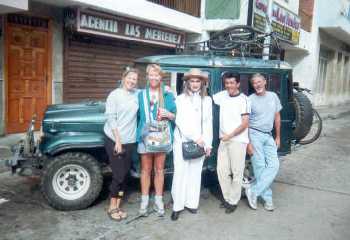
 On Sunday, October 16,
we began our tour of the Pueblos del Sur. We waited in front
of our posada early in the morning to be picked up. The tour agent
warned us in advance that our guide, Diana, wore "a lot of makeup", which
we thought was an odd thing to warn us about. When she arrived in
her Toyota LandCruiser to pick us up, we suddenly understood. The
only way I can describe it is that she was done up in "stage makeup", with
broad swipes of brown around her lips, eyes, and eyebrows. It seemed
designed to be seen from 100 meters away, but it was very unusual in the
short distance across the cabin of a LandCruiser. Still, she was
well informed, friendly, and spoke perfect English with an American accent.
On Sunday, October 16,
we began our tour of the Pueblos del Sur. We waited in front
of our posada early in the morning to be picked up. The tour agent
warned us in advance that our guide, Diana, wore "a lot of makeup", which
we thought was an odd thing to warn us about. When she arrived in
her Toyota LandCruiser to pick us up, we suddenly understood. The
only way I can describe it is that she was done up in "stage makeup", with
broad swipes of brown around her lips, eyes, and eyebrows. It seemed
designed to be seen from 100 meters away, but it was very unusual in the
short distance across the cabin of a LandCruiser. Still, she was
well informed, friendly, and spoke perfect English with an American accent.
Plaza Bolivar, Jaji
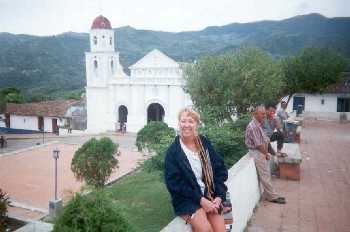 Diana first took
us up to the little village of Jaji (pronounced hah-hee). Like most
villages we saw, Jaji is built around a town square, always called Plaza
Bolivar, with a church fronting one side of the square. The streets
were of cobblestone. The houses and shops were typical whitewashed
buildings with red tile roofs. A few locals sat off at a corner of
the square strumming a guitar and singing in harmony, while others raced
around the streets on their horses. It was a stereotypical Latin
American village, just like you would see in the movies.
Diana first took
us up to the little village of Jaji (pronounced hah-hee). Like most
villages we saw, Jaji is built around a town square, always called Plaza
Bolivar, with a church fronting one side of the square. The streets
were of cobblestone. The houses and shops were typical whitewashed
buildings with red tile roofs. A few locals sat off at a corner of
the square strumming a guitar and singing in harmony, while others raced
around the streets on their horses. It was a stereotypical Latin
American village, just like you would see in the movies.
Indian children parade into church
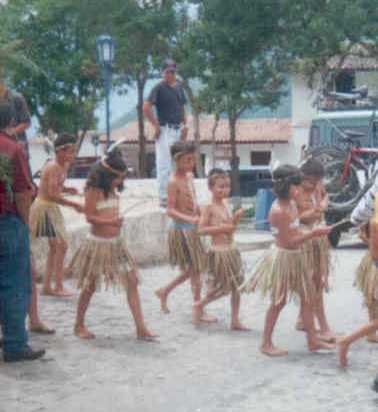 Leaving Jaji, we
met a "parade" coming the other way, consisting of a truck with a shrine
on it, decorated with tree boughs and loaded with people smiling and waving.
Behind them was another truck with about a dozen small children, dressed
up in grass skirts and headbands, in what was presumably native Indian
attire. (Since the conquistadors wiped out the native population
400 years ago, it's hard to say what an authentic native costume was.)
We decided to skip touring a coffee plantation and instead turned back
to Jaji to see what was up.
Leaving Jaji, we
met a "parade" coming the other way, consisting of a truck with a shrine
on it, decorated with tree boughs and loaded with people smiling and waving.
Behind them was another truck with about a dozen small children, dressed
up in grass skirts and headbands, in what was presumably native Indian
attire. (Since the conquistadors wiped out the native population
400 years ago, it's hard to say what an authentic native costume was.)
We decided to skip touring a coffee plantation and instead turned back
to Jaji to see what was up.
When we arrived back at the village, they had set up a procession:
the shrine was brought into the church and up to the altar, followed by
the young group of "Indians". Periodically, some of the men would
shoot off "fireworks" in the plaza, actually bags of black powder tossed
with a lit fuse into a vertical pipe. After the procession entered
the church, things quieted down, and we went on our way.
We rode in the LandCruiser up a winding mountain road, viewing waterfalls
cascading down the hills, until we reached the crest of the road.
There the tour guide stopped the LandCruiser, and we unloaded bicycles
from the back. We enjoyed a wonderful bicycle ride downhill, on a
winding switchback road, through spectacular mountain scenery, to the town
of San Juan in the valley. There we loaded up the bicycles and drove
off for a marvelous lunch at a little restaurant outside of town.
After lunch, Diana drove us up a little dirt road, and we climbed high
up into the mountains, reaching the village of San Jose hours later.
Posada Mochaba, San Jose, Merida
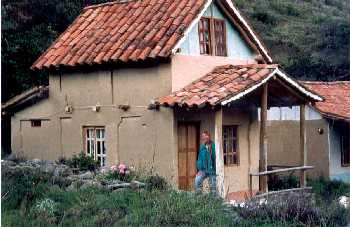 Our posada in San
Jose that night consisted of two private cabins set in a small valley by
a rushing stream. The owners of the posada served us a nice dinner
of grilled trout, with rice and local vegetables. As soon as it was
dark, we went back to our cabins and fell deeply asleep, snuggled up under
two (count 'em, two!) blankets, lulled by the rush of water in the nearby
streambed.
Our posada in San
Jose that night consisted of two private cabins set in a small valley by
a rushing stream. The owners of the posada served us a nice dinner
of grilled trout, with rice and local vegetables. As soon as it was
dark, we went back to our cabins and fell deeply asleep, snuggled up under
two (count 'em, two!) blankets, lulled by the rush of water in the nearby
streambed.
Cathy follows Diana down a steep trail near San Jose
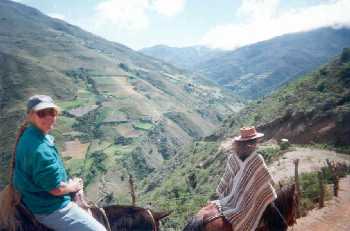 The next morning
we awoke to find another bright, beautiful day. We ate breakfast
at the posada, and then waited for the horses to arrive for our ride.
Cathy, having ridden only a few times before, was a little worried about
how she would do, but the caballero picked a nice, sedate mule for Cathy
instead of a horse, and everything was fine. We rode for about two
hours up into the mountains, down into valleys and across little streams.
The mountains in this part of the Andes are mostly dry scrub, with some
agriculture where it was less hilly, and cattle grazing in the steeper
areas that couldn't be farmed. It reminded me of the high desert
mountains above Deep Springs, California, except that the Andes are even
higher and more beautiful. We arrived at a little farm that happened
to be owned by the tour guide, and just happened to be for sale.
We were tempted to take her up on her offer: even though the houses
were in bad shape, the location was spectacular and the price was very
reasonable. Another two-hour ride by different trails led us back
to the posada.
The next morning
we awoke to find another bright, beautiful day. We ate breakfast
at the posada, and then waited for the horses to arrive for our ride.
Cathy, having ridden only a few times before, was a little worried about
how she would do, but the caballero picked a nice, sedate mule for Cathy
instead of a horse, and everything was fine. We rode for about two
hours up into the mountains, down into valleys and across little streams.
The mountains in this part of the Andes are mostly dry scrub, with some
agriculture where it was less hilly, and cattle grazing in the steeper
areas that couldn't be farmed. It reminded me of the high desert
mountains above Deep Springs, California, except that the Andes are even
higher and more beautiful. We arrived at a little farm that happened
to be owned by the tour guide, and just happened to be for sale.
We were tempted to take her up on her offer: even though the houses
were in bad shape, the location was spectacular and the price was very
reasonable. Another two-hour ride by different trails led us back
to the posada.
Michael gets strapped in for his aborted takeoff attempt
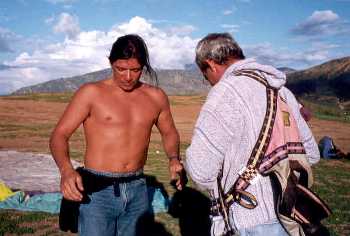 We had lunch at
the posada, and Diana surprised us with a cake in celebration of Michael's
50th birthday. After lunch, we had time to walk around a bit, but
the high altitude caused us to become winded quickly. Around 4 PM,
we loaded our gear into the LandCruiser for the drive down the mountain.
We reached a high promontory over the valley near San Juan and we stopped.
Michael and Kay had booked a paragliding trip as part of the tour, and
this was the jump site. Normally the winds are too strong early in
the day, so we had waited in San Jose before setting out. On this
day, however, the wind was light, and the pilot decided to take the lighter
of the two passengers (Kay) for the first ride. Kay was rushed into
the harness, strapped to the pilot, and hustled off the side of the cliff
before the wind could die any further. We watched and took pictures
as the paraglider slowly descended the thousands of feet to the valley
below. By the time Kay had landed and was driven back up the hill,
the wind had almost died. Michael was strapped in, but after one
aborted takeoff attempt, the pilot decided to scrub any further flights
for the day. We drove back to town in the dark and checked in to
yet another posada, this one next to the tour agency.
We had lunch at
the posada, and Diana surprised us with a cake in celebration of Michael's
50th birthday. After lunch, we had time to walk around a bit, but
the high altitude caused us to become winded quickly. Around 4 PM,
we loaded our gear into the LandCruiser for the drive down the mountain.
We reached a high promontory over the valley near San Juan and we stopped.
Michael and Kay had booked a paragliding trip as part of the tour, and
this was the jump site. Normally the winds are too strong early in
the day, so we had waited in San Jose before setting out. On this
day, however, the wind was light, and the pilot decided to take the lighter
of the two passengers (Kay) for the first ride. Kay was rushed into
the harness, strapped to the pilot, and hustled off the side of the cliff
before the wind could die any further. We watched and took pictures
as the paraglider slowly descended the thousands of feet to the valley
below. By the time Kay had landed and was driven back up the hill,
the wind had almost died. Michael was strapped in, but after one
aborted takeoff attempt, the pilot decided to scrub any further flights
for the day. We drove back to town in the dark and checked in to
yet another posada, this one next to the tour agency.
Michael jumps off a perfectly good cliff
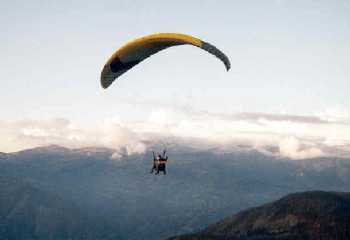 The next day we
waited around until mid-afternoon, when the paragliding guys picked us
up in their LandCruiser, and we went back to the jump site. This
time the conditions were perfect, and Michael had a great ride, catching
lots of thermals, and flying for an hour or more.
The next day we
waited around until mid-afternoon, when the paragliding guys picked us
up in their LandCruiser, and we went back to the jump site. This
time the conditions were perfect, and Michael had a great ride, catching
lots of thermals, and flying for an hour or more.
Unfortunately, somewhere on the trip we caught a cold, and for the next
several days Cathy and I struggled with symptoms that changed from an ordinary
head cold into a stomach flu. We changed posadas a few times trying
to find a quiet place to recuperate. We finally moved to a private
home whose owner, Gioia, occasionally rents rooms to boaters. It
wasn't an official posada listed in any book, but we heard about it from
some other cruisers we had met. It was quiet, cool, clean, and comfortable.
We stayed for four days, taking it easy and trying to get better.
Riding up the Teleferico
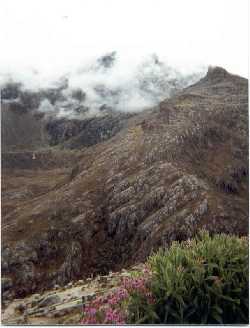 Feeling a little
better, we took the Teleférico, or cable car, up to the top of Pico
Espejo. The Teleférico in Merida is the longest and highest
in the world. It starts in the city at an altitude of 1,577 meters
(5,172 ft.) and climbs in four stages up to the top of Pico Espejo at 4,765
meters (15,629 ft.). It covers a horizontal distance of 12.5 kilometers
(7.5 miles). We had a fabulous view of the mountains during the first
three stages, and as we stopped at each station, we could venture outside
and walk around for about 10 minutes before we boarded the next car.
Each leg takes about 10 minutes, and we watched in awe as the ground dropped
away beneath us and we hung in mid air suspended by only three cables.
As the altitude changes, the ecosystems on the ground change as well, and
we watched the ground cover go from lush sub-tropical foliage, to sparse
dry scrub, to completely barren ground in just a few minutes. By
the time we reached the fourth stage of the ride the clouds had begun to
form for the day, and we didn't get to see any fantastic vistas from the
very top. (We did get to see what the inside of a cloud looks like.)
Feeling a little
better, we took the Teleférico, or cable car, up to the top of Pico
Espejo. The Teleférico in Merida is the longest and highest
in the world. It starts in the city at an altitude of 1,577 meters
(5,172 ft.) and climbs in four stages up to the top of Pico Espejo at 4,765
meters (15,629 ft.). It covers a horizontal distance of 12.5 kilometers
(7.5 miles). We had a fabulous view of the mountains during the first
three stages, and as we stopped at each station, we could venture outside
and walk around for about 10 minutes before we boarded the next car.
Each leg takes about 10 minutes, and we watched in awe as the ground dropped
away beneath us and we hung in mid air suspended by only three cables.
As the altitude changes, the ecosystems on the ground change as well, and
we watched the ground cover go from lush sub-tropical foliage, to sparse
dry scrub, to completely barren ground in just a few minutes. By
the time we reached the fourth stage of the ride the clouds had begun to
form for the day, and we didn't get to see any fantastic vistas from the
very top. (We did get to see what the inside of a cloud looks like.)
Virgin Mary at 15,629 feet
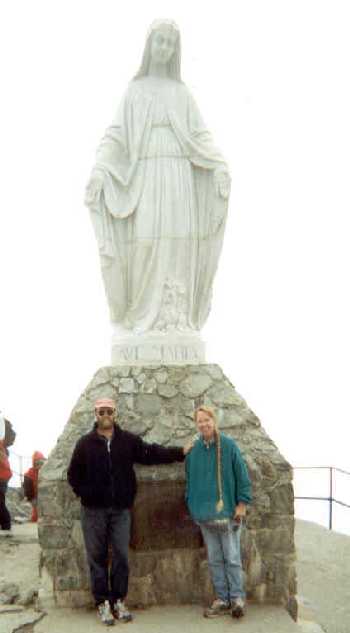 At the top, we
walked around a little and took pictures of each other by the statue of
the Virgin Mary that stands at the top of Pico Espejo. We were both
dizzy from lack of oxygen. The temperature was below freezing, which
I really liked. Unfortunately, my stomach was still having lots of
problems, and the rapid changes in altitude didn't help any, so we avoided
walking down the few hundred meters to the snow banks. Instead, we
went into the cable car station, sipped some hot chocolate, and waited
for the next cable car down. We went straight down, only stopping
at the intermediate cable car stations long enough to change cable cars,
and arrived back on "terra firma" a little after noon.
At the top, we
walked around a little and took pictures of each other by the statue of
the Virgin Mary that stands at the top of Pico Espejo. We were both
dizzy from lack of oxygen. The temperature was below freezing, which
I really liked. Unfortunately, my stomach was still having lots of
problems, and the rapid changes in altitude didn't help any, so we avoided
walking down the few hundred meters to the snow banks. Instead, we
went into the cable car station, sipped some hot chocolate, and waited
for the next cable car down. We went straight down, only stopping
at the intermediate cable car stations long enough to change cable cars,
and arrived back on "terra firma" a little after noon.
Church of Juan Felix Sanchez
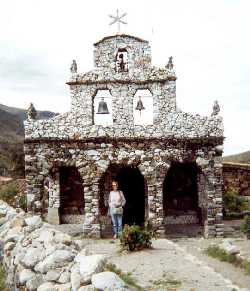 The next day we
took a tour with Gioia to see some of the villages to the north of Merida.
We drove out of town and up the Trans-Andean Highway, stopping at a few
small villages along the way. We stopped at Juan Felix Sanchez Chapel,
a church built of hundreds of thousands of small, odd shaped stones, placed
in such a way that it looked like it would collapse with just a good sneeze.
Its builder, described by Gioia as "a hermit", died in 1997 and is buried
inside along with his wife.
The next day we
took a tour with Gioia to see some of the villages to the north of Merida.
We drove out of town and up the Trans-Andean Highway, stopping at a few
small villages along the way. We stopped at Juan Felix Sanchez Chapel,
a church built of hundreds of thousands of small, odd shaped stones, placed
in such a way that it looked like it would collapse with just a good sneeze.
Its builder, described by Gioia as "a hermit", died in 1997 and is buried
inside along with his wife.
Lago Negro
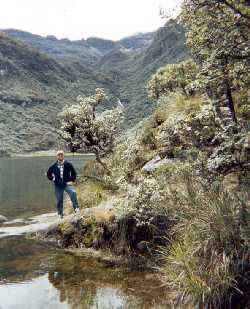 We took about
a two-hour horseback ride to Lago Negro, a glacially formed lake up in
the hills fed by waterfalls. The scenery was different from what
we'd seen on our other ride. Frailejones, the state flower of Merida,
bloomed in profusion, and later when we felt one, it felt like velvet.
For a while we rode through a beautiful forest that reminded us a little
of Maine. The rest of the time there were views of the valley and
mountains. After the horse ride, Gioia took us to lunch at a local
restaurant where the food was delicious. Then we visited a refuge
for the endangered Andean Condor, and saw one of the birds with a three
meter (nine foot) wingspan in a huge cage. On the way back to town,
we were fortunate enough to spot one of the seven wild condors still alive
in Venezuela.
We took about
a two-hour horseback ride to Lago Negro, a glacially formed lake up in
the hills fed by waterfalls. The scenery was different from what
we'd seen on our other ride. Frailejones, the state flower of Merida,
bloomed in profusion, and later when we felt one, it felt like velvet.
For a while we rode through a beautiful forest that reminded us a little
of Maine. The rest of the time there were views of the valley and
mountains. After the horse ride, Gioia took us to lunch at a local
restaurant where the food was delicious. Then we visited a refuge
for the endangered Andean Condor, and saw one of the birds with a three
meter (nine foot) wingspan in a huge cage. On the way back to town,
we were fortunate enough to spot one of the seven wild condors still alive
in Venezuela.
We spent the next day taking it easy at Gioia's house, hoping for my
stomach to "be nice", and decided to leave the following day. We
packed all our bags, and arrived at the bus station in the early afternoon,
about an hour and a half before the bus was supposed to leave. Unfortunately,
by that time all the seats had been sold, and the next bus to Puerto La
Cruz didn't leave until the following day. We looked at all of our
options, and decided to try the bus to Caracas that left only two and a
half hours after the one we had intended to take. From there, we
figured connections to Puerto La Cruz would be easy. The bus to Caracas
was listed as "semi-ejecutivo". We asked what that meant, and the
man at the ticket window said it had air conditioning and television, but
no "camas", meaning beds or the reclining seats. It sounded fine,
so we bought the tickets.
It finally came time to board, and we loaded up. The bus was empty
except for Cathy, Michael, Kay, and me, and that's when we started to wonder.
Just before we left, a young boy got on, but he was only going to the next
town. As we left the station, we inspected the bus. True to
the ticket seller's word, there were no "camas" on the bus, just normal
seats which, after ten minutes of sitting, we decided must have originally
been designed as torture devices. The bus did have a television and
VCR, but the driver did not have any tapes for it. The air conditioning
worked after a fashion, but it ground and gasped loudly and only emitted
a faint wisp of coolness. Cathy discovered that the cover to my head-rest
was crawling with little white bugs that we assume were just-hatched lice.
But the worst problem was that there was no bathroom! My stomach
had been gurgling and grumbling for five days, and I wondered if I would
survive the ride.
We rode for twelve hours on that bus, with many short stops at small
towns along the way. The bus gradually filled up until it was packed.
At about 4:00 the next morning, the driver woke us up and asked if we wanted
to go to Puerto La Cruz. We did, and he hustled us off his bus, and
onto another one parked right in front. We paid the driver more money
for the other bus, and climbed aboard. This one was a proper "ejecutivo",
with bathrooms, comfortable seats, and a powerful air conditioner.
We took the last seats available, and quickly fell asleep. After
breakfast, they played a movie (the same as one we saw on the trip up).
Later on we struck up a conversation with a group of college-age Columbian
Seventh Day Adventists, and we conversed with them in broken English and
Spanish for much of the rest of the ride.
Back at Bahia Redonda Marina, Puerto La Cruz
 Finally, about
2:00 PM on October 24th, we arrived in Puerto La Cruz. We stepped
off the bus and into the searing heat of early afternoon. We arrived
back at the boat hot, exhausted, and still a little sick, but glad to have
made the trip. In more than two weeks we had seen beautiful mountains,
rushing rivers, placid glacial lakes, and friendly people, all set in a
fantastic climate. But we had only seen a handful of foreign tourists.
We finally believe the travel posters: It really IS the best kept
secret in the Caribbean. Promise not to tell?
Finally, about
2:00 PM on October 24th, we arrived in Puerto La Cruz. We stepped
off the bus and into the searing heat of early afternoon. We arrived
back at the boat hot, exhausted, and still a little sick, but glad to have
made the trip. In more than two weeks we had seen beautiful mountains,
rushing rivers, placid glacial lakes, and friendly people, all set in a
fantastic climate. But we had only seen a handful of foreign tourists.
We finally believe the travel posters: It really IS the best kept
secret in the Caribbean. Promise not to tell?
Smooth sailing,
Jim and Cathy
 We arrived in Merida
the next morning around 6:00 A.M., and when we stepped off the bus into
the bright, crisp morning air that only a mile-high city can provide, we
knew we were in the right place. At about 9 degrees of latitude north
of the equator, the temperatures are consistent all year round, and at
an altitude of a mile above sea level, they are also very agreeable.
Highs are typically in the mid-seventies Fahrenheit, and lows are around
60--like a New England summer--all year long!
We arrived in Merida
the next morning around 6:00 A.M., and when we stepped off the bus into
the bright, crisp morning air that only a mile-high city can provide, we
knew we were in the right place. At about 9 degrees of latitude north
of the equator, the temperatures are consistent all year round, and at
an altitude of a mile above sea level, they are also very agreeable.
Highs are typically in the mid-seventies Fahrenheit, and lows are around
60--like a New England summer--all year long!
 After breakfast
at the bus station coffee shop, we caught a local bus to downtown Merida
and began the Great Posada Hunt. Posadas are like "Bed and Breakfast"
Inns in the U.S., but posadas typically don't serve food if restaurants
are available nearby. Armed with a book listing every posada in Venezuela,
we began the hunt. We picked a half dozen likely prospects out of
the 48 posadas listed in Merida, mapped them out, and set off. The
posadas varied drastically in quality: one had rooms that looked
literally like prison cells, with metal barred doors opening onto a lone
bed and lit by a naked bulb hanging from the ceiling; other posadas were
simple hotels with a front desk and basic rooms with a private bathroom;
still others were private houses offering spare bedrooms. We finally
chose one of the latter--a room with two double beds, three bunk beds,
a TV, and a private bath, all of which we shared with Michael and Kay.
We spent the rest of the day taking it easy, watching TV, snoozing, and
generally trying to recover from the long bus ride.
After breakfast
at the bus station coffee shop, we caught a local bus to downtown Merida
and began the Great Posada Hunt. Posadas are like "Bed and Breakfast"
Inns in the U.S., but posadas typically don't serve food if restaurants
are available nearby. Armed with a book listing every posada in Venezuela,
we began the hunt. We picked a half dozen likely prospects out of
the 48 posadas listed in Merida, mapped them out, and set off. The
posadas varied drastically in quality: one had rooms that looked
literally like prison cells, with metal barred doors opening onto a lone
bed and lit by a naked bulb hanging from the ceiling; other posadas were
simple hotels with a front desk and basic rooms with a private bathroom;
still others were private houses offering spare bedrooms. We finally
chose one of the latter--a room with two double beds, three bunk beds,
a TV, and a private bath, all of which we shared with Michael and Kay.
We spent the rest of the day taking it easy, watching TV, snoozing, and
generally trying to recover from the long bus ride.
 Merida is a beautiful
city. It sits on a sloping plateau in a long narrow valley, bordered
by two parallel rivers, and enclosed by two parallel mountain ranges, the
Sierra Nevada and Sierra La Culata, that reach high into the stunningly
clear blue sky. From many of the lovely parks or "plazas" in town,
one or more of the snow-capped peaks are usually visible, including Pico
Bolivar, the highest in Venezuela, which rises to 5007 meters (16,423 ft.).
The city is home to the Universidad de los Andes, and so it has a huge
population of young adults. Unlike most of Venezuela, the city is
clean, with no litter visible anywhere. Except for the churches,
the buildings in the city are typically low, usually two stories, and usually
are whitewashed with red tile roofs.
Merida is a beautiful
city. It sits on a sloping plateau in a long narrow valley, bordered
by two parallel rivers, and enclosed by two parallel mountain ranges, the
Sierra Nevada and Sierra La Culata, that reach high into the stunningly
clear blue sky. From many of the lovely parks or "plazas" in town,
one or more of the snow-capped peaks are usually visible, including Pico
Bolivar, the highest in Venezuela, which rises to 5007 meters (16,423 ft.).
The city is home to the Universidad de los Andes, and so it has a huge
population of young adults. Unlike most of Venezuela, the city is
clean, with no litter visible anywhere. Except for the churches,
the buildings in the city are typically low, usually two stories, and usually
are whitewashed with red tile roofs.
 No other such grand
drama marked the next few days. Cathy and Kay explored the nooks
and crannies of the shops of Merida, and we hiked around the city and enjoyed
the sights and sounds. We basked in the sunny, cool and crisp weather,
and we adjusted to air much thinner than what we were accustomed to from
years of living exactly at sea level. Cathy met a young local girl,
Alejandra, who mentioned that there would be a celebration of the 442nd
anniversary of the founding of Merida the next day. Alejandra was
to dance at the celebration, and there would be music as well. So
we attended the celebration and were delighted to listen to the local music
and watch the folk dancing.
No other such grand
drama marked the next few days. Cathy and Kay explored the nooks
and crannies of the shops of Merida, and we hiked around the city and enjoyed
the sights and sounds. We basked in the sunny, cool and crisp weather,
and we adjusted to air much thinner than what we were accustomed to from
years of living exactly at sea level. Cathy met a young local girl,
Alejandra, who mentioned that there would be a celebration of the 442nd
anniversary of the founding of Merida the next day. Alejandra was
to dance at the celebration, and there would be music as well. So
we attended the celebration and were delighted to listen to the local music
and watch the folk dancing.

 On Sunday, October 16,
we began our tour of the Pueblos del Sur. We waited in front
of our posada early in the morning to be picked up. The tour agent
warned us in advance that our guide, Diana, wore "a lot of makeup", which
we thought was an odd thing to warn us about. When she arrived in
her Toyota LandCruiser to pick us up, we suddenly understood. The
only way I can describe it is that she was done up in "stage makeup", with
broad swipes of brown around her lips, eyes, and eyebrows. It seemed
designed to be seen from 100 meters away, but it was very unusual in the
short distance across the cabin of a LandCruiser. Still, she was
well informed, friendly, and spoke perfect English with an American accent.
On Sunday, October 16,
we began our tour of the Pueblos del Sur. We waited in front
of our posada early in the morning to be picked up. The tour agent
warned us in advance that our guide, Diana, wore "a lot of makeup", which
we thought was an odd thing to warn us about. When she arrived in
her Toyota LandCruiser to pick us up, we suddenly understood. The
only way I can describe it is that she was done up in "stage makeup", with
broad swipes of brown around her lips, eyes, and eyebrows. It seemed
designed to be seen from 100 meters away, but it was very unusual in the
short distance across the cabin of a LandCruiser. Still, she was
well informed, friendly, and spoke perfect English with an American accent.
 Diana first took
us up to the little village of Jaji (pronounced hah-hee). Like most
villages we saw, Jaji is built around a town square, always called Plaza
Bolivar, with a church fronting one side of the square. The streets
were of cobblestone. The houses and shops were typical whitewashed
buildings with red tile roofs. A few locals sat off at a corner of
the square strumming a guitar and singing in harmony, while others raced
around the streets on their horses. It was a stereotypical Latin
American village, just like you would see in the movies.
Diana first took
us up to the little village of Jaji (pronounced hah-hee). Like most
villages we saw, Jaji is built around a town square, always called Plaza
Bolivar, with a church fronting one side of the square. The streets
were of cobblestone. The houses and shops were typical whitewashed
buildings with red tile roofs. A few locals sat off at a corner of
the square strumming a guitar and singing in harmony, while others raced
around the streets on their horses. It was a stereotypical Latin
American village, just like you would see in the movies.
 Leaving Jaji, we
met a "parade" coming the other way, consisting of a truck with a shrine
on it, decorated with tree boughs and loaded with people smiling and waving.
Behind them was another truck with about a dozen small children, dressed
up in grass skirts and headbands, in what was presumably native Indian
attire. (Since the conquistadors wiped out the native population
400 years ago, it's hard to say what an authentic native costume was.)
We decided to skip touring a coffee plantation and instead turned back
to Jaji to see what was up.
Leaving Jaji, we
met a "parade" coming the other way, consisting of a truck with a shrine
on it, decorated with tree boughs and loaded with people smiling and waving.
Behind them was another truck with about a dozen small children, dressed
up in grass skirts and headbands, in what was presumably native Indian
attire. (Since the conquistadors wiped out the native population
400 years ago, it's hard to say what an authentic native costume was.)
We decided to skip touring a coffee plantation and instead turned back
to Jaji to see what was up.
 Our posada in San
Jose that night consisted of two private cabins set in a small valley by
a rushing stream. The owners of the posada served us a nice dinner
of grilled trout, with rice and local vegetables. As soon as it was
dark, we went back to our cabins and fell deeply asleep, snuggled up under
two (count 'em, two!) blankets, lulled by the rush of water in the nearby
streambed.
Our posada in San
Jose that night consisted of two private cabins set in a small valley by
a rushing stream. The owners of the posada served us a nice dinner
of grilled trout, with rice and local vegetables. As soon as it was
dark, we went back to our cabins and fell deeply asleep, snuggled up under
two (count 'em, two!) blankets, lulled by the rush of water in the nearby
streambed.
 The next morning
we awoke to find another bright, beautiful day. We ate breakfast
at the posada, and then waited for the horses to arrive for our ride.
Cathy, having ridden only a few times before, was a little worried about
how she would do, but the caballero picked a nice, sedate mule for Cathy
instead of a horse, and everything was fine. We rode for about two
hours up into the mountains, down into valleys and across little streams.
The mountains in this part of the Andes are mostly dry scrub, with some
agriculture where it was less hilly, and cattle grazing in the steeper
areas that couldn't be farmed. It reminded me of the high desert
mountains above Deep Springs, California, except that the Andes are even
higher and more beautiful. We arrived at a little farm that happened
to be owned by the tour guide, and just happened to be for sale.
We were tempted to take her up on her offer: even though the houses
were in bad shape, the location was spectacular and the price was very
reasonable. Another two-hour ride by different trails led us back
to the posada.
The next morning
we awoke to find another bright, beautiful day. We ate breakfast
at the posada, and then waited for the horses to arrive for our ride.
Cathy, having ridden only a few times before, was a little worried about
how she would do, but the caballero picked a nice, sedate mule for Cathy
instead of a horse, and everything was fine. We rode for about two
hours up into the mountains, down into valleys and across little streams.
The mountains in this part of the Andes are mostly dry scrub, with some
agriculture where it was less hilly, and cattle grazing in the steeper
areas that couldn't be farmed. It reminded me of the high desert
mountains above Deep Springs, California, except that the Andes are even
higher and more beautiful. We arrived at a little farm that happened
to be owned by the tour guide, and just happened to be for sale.
We were tempted to take her up on her offer: even though the houses
were in bad shape, the location was spectacular and the price was very
reasonable. Another two-hour ride by different trails led us back
to the posada.
 We had lunch at
the posada, and Diana surprised us with a cake in celebration of Michael's
50th birthday. After lunch, we had time to walk around a bit, but
the high altitude caused us to become winded quickly. Around 4 PM,
we loaded our gear into the LandCruiser for the drive down the mountain.
We reached a high promontory over the valley near San Juan and we stopped.
Michael and Kay had booked a paragliding trip as part of the tour, and
this was the jump site. Normally the winds are too strong early in
the day, so we had waited in San Jose before setting out. On this
day, however, the wind was light, and the pilot decided to take the lighter
of the two passengers (Kay) for the first ride. Kay was rushed into
the harness, strapped to the pilot, and hustled off the side of the cliff
before the wind could die any further. We watched and took pictures
as the paraglider slowly descended the thousands of feet to the valley
below. By the time Kay had landed and was driven back up the hill,
the wind had almost died. Michael was strapped in, but after one
aborted takeoff attempt, the pilot decided to scrub any further flights
for the day. We drove back to town in the dark and checked in to
yet another posada, this one next to the tour agency.
We had lunch at
the posada, and Diana surprised us with a cake in celebration of Michael's
50th birthday. After lunch, we had time to walk around a bit, but
the high altitude caused us to become winded quickly. Around 4 PM,
we loaded our gear into the LandCruiser for the drive down the mountain.
We reached a high promontory over the valley near San Juan and we stopped.
Michael and Kay had booked a paragliding trip as part of the tour, and
this was the jump site. Normally the winds are too strong early in
the day, so we had waited in San Jose before setting out. On this
day, however, the wind was light, and the pilot decided to take the lighter
of the two passengers (Kay) for the first ride. Kay was rushed into
the harness, strapped to the pilot, and hustled off the side of the cliff
before the wind could die any further. We watched and took pictures
as the paraglider slowly descended the thousands of feet to the valley
below. By the time Kay had landed and was driven back up the hill,
the wind had almost died. Michael was strapped in, but after one
aborted takeoff attempt, the pilot decided to scrub any further flights
for the day. We drove back to town in the dark and checked in to
yet another posada, this one next to the tour agency.
 The next day we
waited around until mid-afternoon, when the paragliding guys picked us
up in their LandCruiser, and we went back to the jump site. This
time the conditions were perfect, and Michael had a great ride, catching
lots of thermals, and flying for an hour or more.
The next day we
waited around until mid-afternoon, when the paragliding guys picked us
up in their LandCruiser, and we went back to the jump site. This
time the conditions were perfect, and Michael had a great ride, catching
lots of thermals, and flying for an hour or more.
 Feeling a little
better, we took the Teleférico, or cable car, up to the top of Pico
Espejo. The Teleférico in Merida is the longest and highest
in the world. It starts in the city at an altitude of 1,577 meters
(5,172 ft.) and climbs in four stages up to the top of Pico Espejo at 4,765
meters (15,629 ft.). It covers a horizontal distance of 12.5 kilometers
(7.5 miles). We had a fabulous view of the mountains during the first
three stages, and as we stopped at each station, we could venture outside
and walk around for about 10 minutes before we boarded the next car.
Each leg takes about 10 minutes, and we watched in awe as the ground dropped
away beneath us and we hung in mid air suspended by only three cables.
As the altitude changes, the ecosystems on the ground change as well, and
we watched the ground cover go from lush sub-tropical foliage, to sparse
dry scrub, to completely barren ground in just a few minutes. By
the time we reached the fourth stage of the ride the clouds had begun to
form for the day, and we didn't get to see any fantastic vistas from the
very top. (We did get to see what the inside of a cloud looks like.)
Feeling a little
better, we took the Teleférico, or cable car, up to the top of Pico
Espejo. The Teleférico in Merida is the longest and highest
in the world. It starts in the city at an altitude of 1,577 meters
(5,172 ft.) and climbs in four stages up to the top of Pico Espejo at 4,765
meters (15,629 ft.). It covers a horizontal distance of 12.5 kilometers
(7.5 miles). We had a fabulous view of the mountains during the first
three stages, and as we stopped at each station, we could venture outside
and walk around for about 10 minutes before we boarded the next car.
Each leg takes about 10 minutes, and we watched in awe as the ground dropped
away beneath us and we hung in mid air suspended by only three cables.
As the altitude changes, the ecosystems on the ground change as well, and
we watched the ground cover go from lush sub-tropical foliage, to sparse
dry scrub, to completely barren ground in just a few minutes. By
the time we reached the fourth stage of the ride the clouds had begun to
form for the day, and we didn't get to see any fantastic vistas from the
very top. (We did get to see what the inside of a cloud looks like.)
 At the top, we
walked around a little and took pictures of each other by the statue of
the Virgin Mary that stands at the top of Pico Espejo. We were both
dizzy from lack of oxygen. The temperature was below freezing, which
I really liked. Unfortunately, my stomach was still having lots of
problems, and the rapid changes in altitude didn't help any, so we avoided
walking down the few hundred meters to the snow banks. Instead, we
went into the cable car station, sipped some hot chocolate, and waited
for the next cable car down. We went straight down, only stopping
at the intermediate cable car stations long enough to change cable cars,
and arrived back on "terra firma" a little after noon.
At the top, we
walked around a little and took pictures of each other by the statue of
the Virgin Mary that stands at the top of Pico Espejo. We were both
dizzy from lack of oxygen. The temperature was below freezing, which
I really liked. Unfortunately, my stomach was still having lots of
problems, and the rapid changes in altitude didn't help any, so we avoided
walking down the few hundred meters to the snow banks. Instead, we
went into the cable car station, sipped some hot chocolate, and waited
for the next cable car down. We went straight down, only stopping
at the intermediate cable car stations long enough to change cable cars,
and arrived back on "terra firma" a little after noon.
 The next day we
took a tour with Gioia to see some of the villages to the north of Merida.
We drove out of town and up the Trans-Andean Highway, stopping at a few
small villages along the way. We stopped at Juan Felix Sanchez Chapel,
a church built of hundreds of thousands of small, odd shaped stones, placed
in such a way that it looked like it would collapse with just a good sneeze.
Its builder, described by Gioia as "a hermit", died in 1997 and is buried
inside along with his wife.
The next day we
took a tour with Gioia to see some of the villages to the north of Merida.
We drove out of town and up the Trans-Andean Highway, stopping at a few
small villages along the way. We stopped at Juan Felix Sanchez Chapel,
a church built of hundreds of thousands of small, odd shaped stones, placed
in such a way that it looked like it would collapse with just a good sneeze.
Its builder, described by Gioia as "a hermit", died in 1997 and is buried
inside along with his wife.
 We took about
a two-hour horseback ride to Lago Negro, a glacially formed lake up in
the hills fed by waterfalls. The scenery was different from what
we'd seen on our other ride. Frailejones, the state flower of Merida,
bloomed in profusion, and later when we felt one, it felt like velvet.
For a while we rode through a beautiful forest that reminded us a little
of Maine. The rest of the time there were views of the valley and
mountains. After the horse ride, Gioia took us to lunch at a local
restaurant where the food was delicious. Then we visited a refuge
for the endangered Andean Condor, and saw one of the birds with a three
meter (nine foot) wingspan in a huge cage. On the way back to town,
we were fortunate enough to spot one of the seven wild condors still alive
in Venezuela.
We took about
a two-hour horseback ride to Lago Negro, a glacially formed lake up in
the hills fed by waterfalls. The scenery was different from what
we'd seen on our other ride. Frailejones, the state flower of Merida,
bloomed in profusion, and later when we felt one, it felt like velvet.
For a while we rode through a beautiful forest that reminded us a little
of Maine. The rest of the time there were views of the valley and
mountains. After the horse ride, Gioia took us to lunch at a local
restaurant where the food was delicious. Then we visited a refuge
for the endangered Andean Condor, and saw one of the birds with a three
meter (nine foot) wingspan in a huge cage. On the way back to town,
we were fortunate enough to spot one of the seven wild condors still alive
in Venezuela.
 Finally, about
2:00 PM on October 24th, we arrived in Puerto La Cruz. We stepped
off the bus and into the searing heat of early afternoon. We arrived
back at the boat hot, exhausted, and still a little sick, but glad to have
made the trip. In more than two weeks we had seen beautiful mountains,
rushing rivers, placid glacial lakes, and friendly people, all set in a
fantastic climate. But we had only seen a handful of foreign tourists.
We finally believe the travel posters: It really IS the best kept
secret in the Caribbean. Promise not to tell?
Finally, about
2:00 PM on October 24th, we arrived in Puerto La Cruz. We stepped
off the bus and into the searing heat of early afternoon. We arrived
back at the boat hot, exhausted, and still a little sick, but glad to have
made the trip. In more than two weeks we had seen beautiful mountains,
rushing rivers, placid glacial lakes, and friendly people, all set in a
fantastic climate. But we had only seen a handful of foreign tourists.
We finally believe the travel posters: It really IS the best kept
secret in the Caribbean. Promise not to tell?